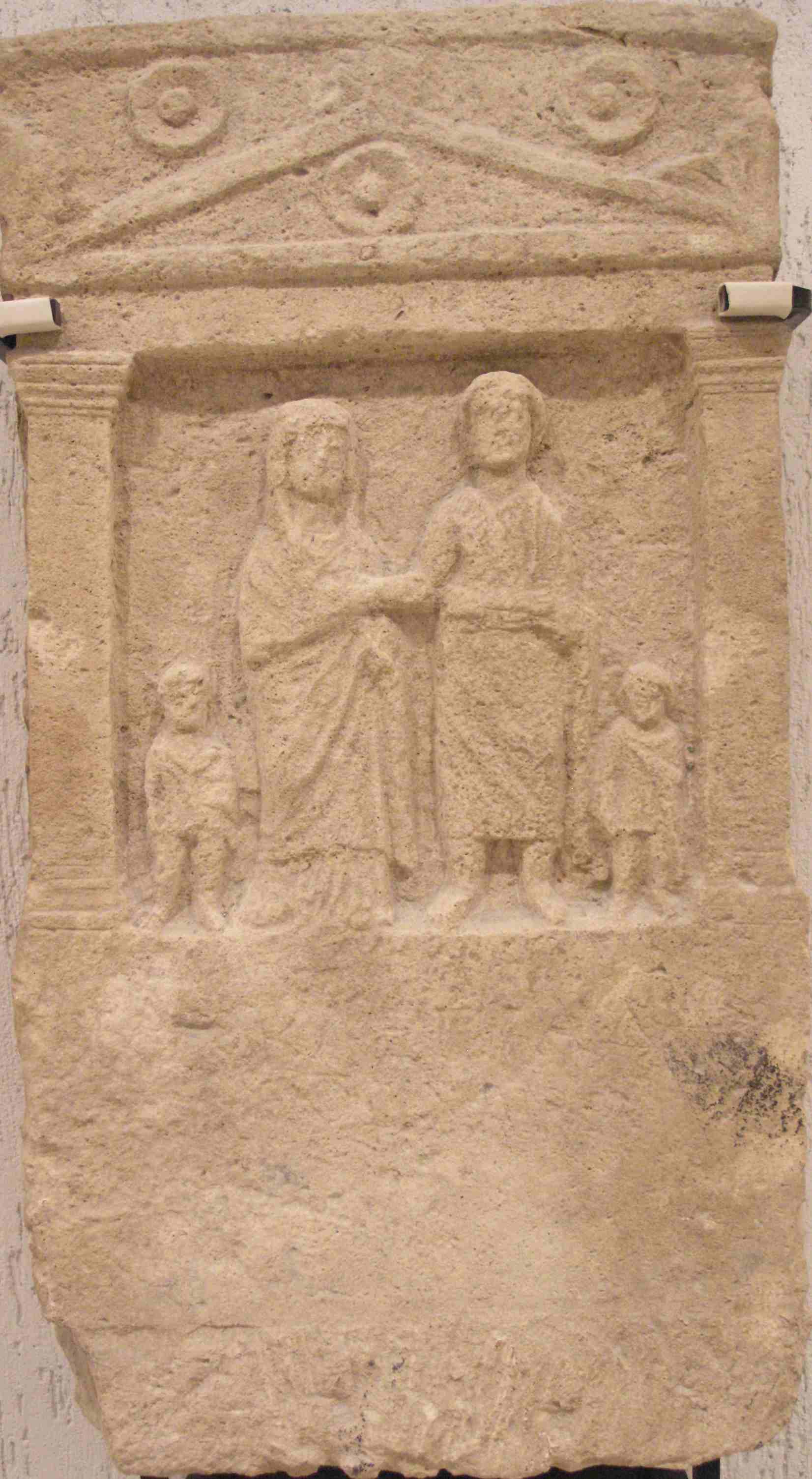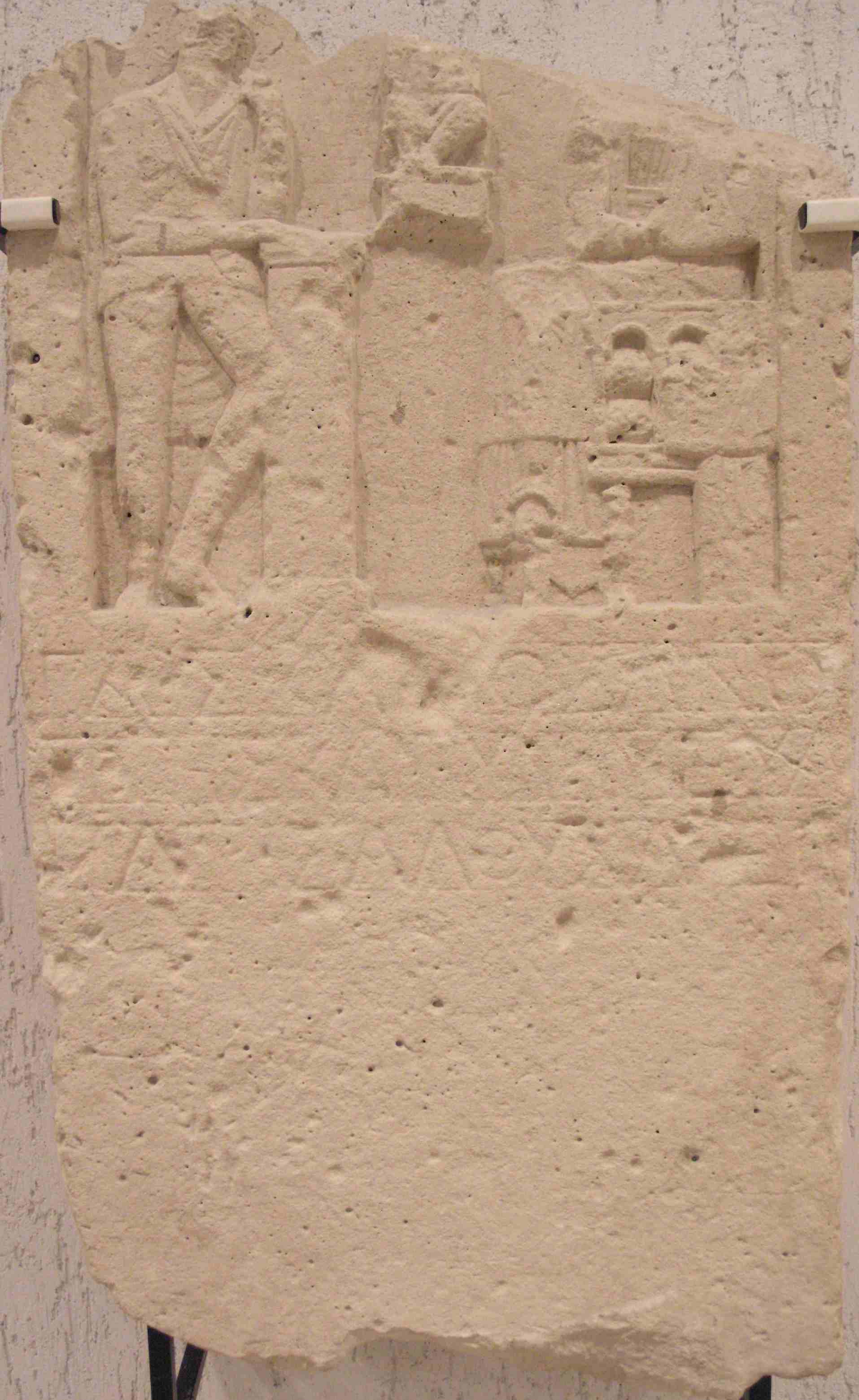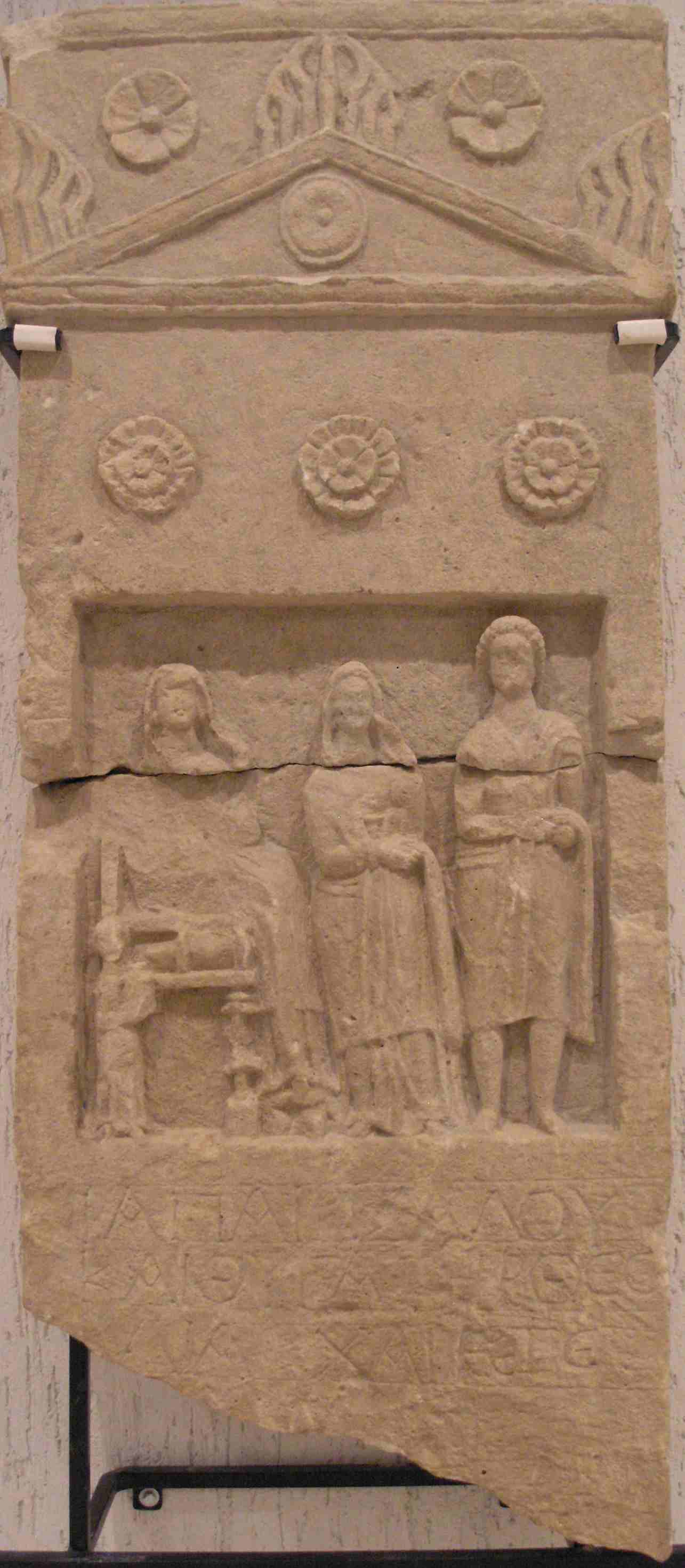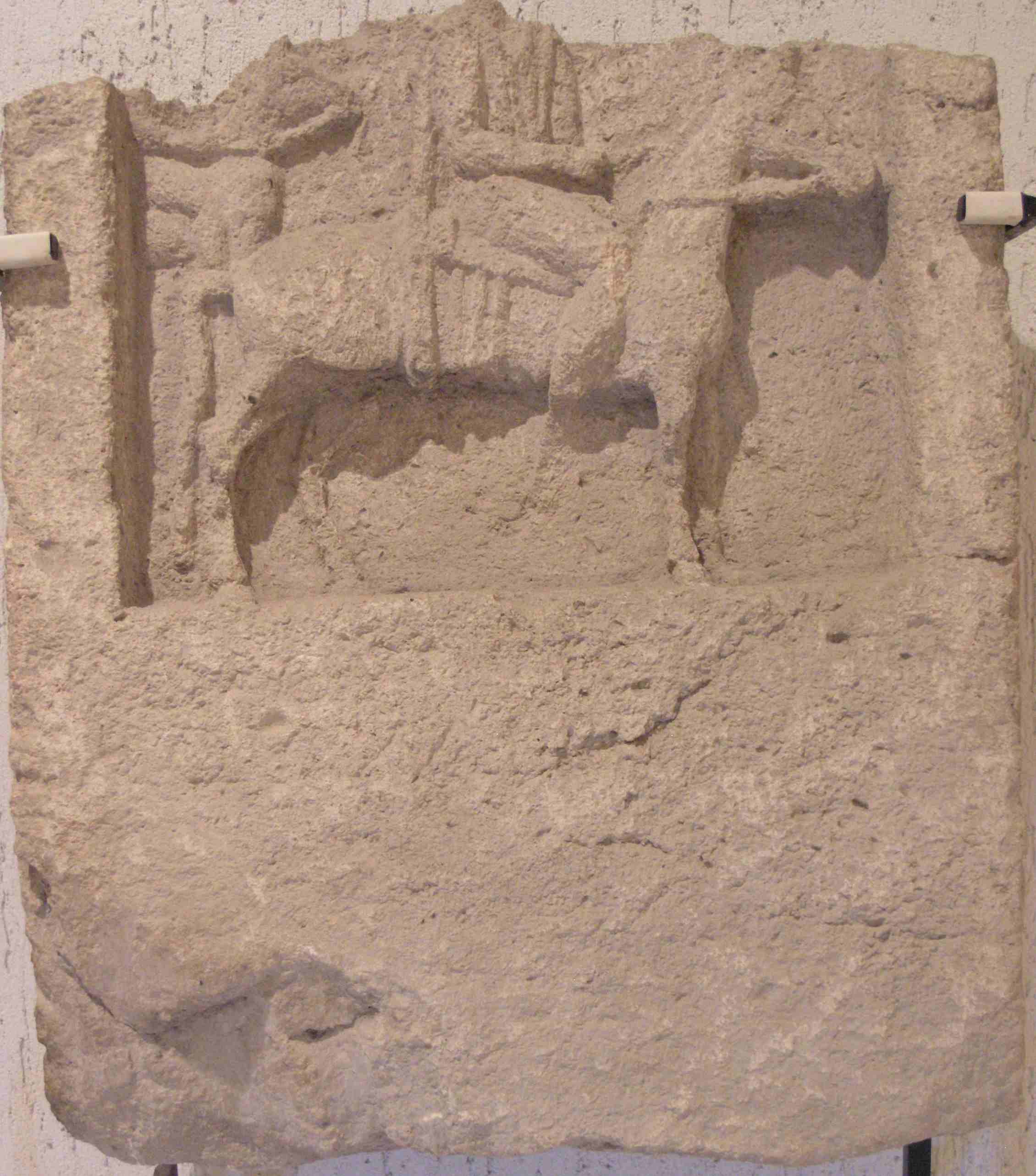
Four unpublished funerary stele from Pantikapaion[1]
Funerary stele of Asclepiades

No inv.: Demetra Found 01
Found in Kerch, in the year 2004.
Dimensions: H 76, 5 cm; W 41, 5 cm; Th. 13 cm
Material: Limestone
Description: Funerary stele with tympanum and relief representing in central space standing man (on right) and woman (on left) holding their hands and two small persons (servants) on each side. Tympanum is decorated with rosettes and both sides of the relief are marked with pilasters. Very bottom part of the stele is not well elaborated this part was inserted in stand. Two lines of Greek text are situated below the relief.
Description of the text: Angular letters, pointed with straight serifs, are hard visible. Alpha with straight cross-stroke and minims crossed and going over the headline; Pi with right minim of a half length. First letter of the first line (A) is placed in upper position to the rest of the line. Most probably it was determined by the scared surface of the stone. Similar situation may be with the beginning of the second line.
Dimensions of letters: Alpha - H 3, 5 cm, W 2, 5 cm; Delta - 2, 5 cm, W 3 cm; Lambda - H 3 cm; W 3 cm; Upper margin 4 cm
Preservation and condition: Stele is preserved almost untouched. The surface is weathered and partly scared as well as soiled with black colour (tar?). Letters are hardly visible, especially at the beginning of the verses.
Date: 1st century AD (palaeography and relief style)
Text:
1. )A?s?klepia/dhj
2. ....ou Xai=re
Translation:
Bibliography: Unpublished
Commentary:
L. 1 Asclepiades is very popular Greek name known among others also in KBN: 1001 (Phanagoria); 1276; 676 (Asclepiades, son of Apollonius, 2 century AD?); 996 (Asclepiades, son of Apollonius); 1277 l. 12 (Asclepiades, son of Valerius); 1280, ll. 6-7 (Asclepiades, son of Valerius, filagathos). Further Asclepiades as father: 1278, l. 28; 1001 (of Demetrius); 491 (of Perigenes); 1287, l. 11-12 (of Xarthanos); 1282, ll. 19-20 (of Sozirauos); 676 (of daughter Hedeia, 2 century AD?).
Similar type of relief style are for example KBN 132 (found in Kerch, in the year 1888, now in the Hermitage Museum, PAN 1621, dated after palaeography for 1st half of the 1st century AD, probably of the same workshop); KBN 361 (similar workshop?, difference consists in only one servant standing by the side of woman, found in the year 1879 at the Mount Mithridates in Kerch, now in the Historical Museum in Moscow, inv. no 5709[22], B-1776, palaeographically dated for the 1st century AD).
Funerary stele of Gaius, his son Anoptes and his wife Meua, daughter of Pairisades

No inv.: Demetra Found 02
Found in Kerch, in the 2004.
Dimensions: H 83, 5 cm; W 46, 5 cm; Th. 19 cm
Material: Limestone
Description: Stele ornamented with relief representing standing man, resting on the altar and, in the opposite side, with a women sitting on a throne. Below the relief are three lines of the Greek text.
Description of the text: Angular letters with serifs. Alpha with broken cross-stroke; Pi with very short and oblique right minim. Similar script seems to be similar with KBN 38, dated for the reign of Dynamis (17 BC-8 BC).
Dimensions of letters: Omicron - 3x3 cm; Sigma - W 3 cm; Nu - W 2, 5 cm; Epsilon - W 2, 5 cm (middle stroke - 2 cm); Upper margin - 2, 2 cm; Margins - 1 cm; H of rulers - 3, 5 cm.
Preservation and condition: Upper part of the stele is broken, as well as very bottom part. Head of the sitting women is not preserved, although head of the standing man remains.
Date: 1st century BC 1st century AD (palaeography; names Gaius and Pairisades see commentary).
Text:
Ga/i+j k?a?[i\ u(]i?o\j )Ano/-
pthj kai\ gunh\ Meu/a
Pairisa/dou xai/rein
Translation:
Bibliography: Unpublished
Commentary:
L. 1 The form Gais (Gaius) is known from many inscriptions although I did not found example from the northern Black Sea.
L. 1-2 Anoptes is rare name. It appears for example in Italy (IG XIV 868, Kyme, without date but seems to be early) and in Black Sea area (KBN 775, Glinishche, dated by Latyshev simple for Roman period). Similar name, more popular in the region, is Anoptenis (KBN no 282, Pantikapaion, 2nd half of 1st century BC; no 348, Pantikapaion, 1st century AD; no 545, Pantikapaion, 1st century AD; no 620, Pantikapaion, end of 1st beginning of 2nd century AD; no 631, Pantikapaion, 50-200 AD; no 781, Pantikapaion, without date (I suppose palaeographically it could be at earliest 1st century AD). The name Anoptes is also known from Latin inscriptions as for example: Publius Usulenus Anoptes from Catalonia in Spain (CIL XII 4479, conf. M. Christol, R. Plana Mallart, Els negotiatores de Narbona i el vi català, Faventia 19.2 (1997), pp. 84-85). All known Anoptes in Latin inscriptions were libertini. It supports impression, that we have to do with a roman libertinus and probably trader who have had married a native women.
L. 2 The name Meua, daughter of Pairisades, is nomen hapax although we know the name Meuakos, which appears only in the northern shores of the Black Sea (KBN 1280, Anthitenes Meuakou and Nauakos Meuakou, Tanais 225 AD; 1245, Nauakos Meuakou, Tanais, 220 AD; 35 Barbarios M[eu]a(kou)?, Pantikapaion 275-279 AD).
L. 3 The name of Pairisades appears in inscriptions several times also outside Crimea (FD III 3, Delphi, circa 150 BC; IG II (2), 212, Athens 4th century BC; IG XI, 2, 287 face B, Delos, 250 BC; IDelos 298 face A, Delos, 240 BC; IDelos 313, fr. Ab, Delos 235-234 BC?; IDelos 314 face B, Delos 235-234 BC; IDelos 320 face B, Delos 229 BC; IDid 66, Didymai 464 BC). All these mentions concern kings from the Spartokid dynasty. In KBN and IOSPE Pairisades appears very numerous and the latest of them is dated for end of the 2nd century BC. The last king with this name (and last king of the Spartokid dynasty) ruled in years 125-108 BC. This is not serious embarrassment, although palaeography suggests period about century later, because our Pairisades is a father of deceased Meua, wife of deceased Gaius and probably mother of deceased Anoptes. The name Gaius suggests 1st century even.
There is also other interesting point most epigraphic mentions about Pairisades concerns kings of the Spartokid dynasty and literary sources mention only these kings. Ordinary people with this name appear only one in KBN (no 1041, Hermonassa, 4th century BC). Palaeography speaks for possible late date, so I would like propose second half of the 1st century BC or beginning of the 1st century AD.
Funerary stele of Ia(s)?, son of Pairisades and his daughter Theokleia

No inv.: Demetra Found 03
Found in Kerch, in the 2004.
Dimensions: H 111, 5 cm; W 48, 5 cm; Th. 15, 3 cm
Material: Limestone
Description: Funerary stele with tympanum decorated with acroterion and rosettes and relief representing women sitting on throne, standing women and standing man. Below the relief are three lines of Greek inscription.
Description of the text: Lunar shaped letters with triangular serifs in rulers. Rulers are at the beginning more narrow and at the end wider. Letters are smaller that rulers allow and do not touch head- and baselines. Alpha is with broken cross-stroke; Theta with the inner stroke, do not touching bowl; middle stroke in Eta do not touch the bowl; both minims in Pi are of the same length.
Dimensions of letters: Theta - H 3, 5 cm, W 3, 5 cm; Epsilon - H 3 cm, W 2, 5 cm.
Preservation and condition: Stele is split in the middle of its high. Additionally bottom part of the stone is broken out.
Date: 2nd century BC (palaeography)
Text:
)/Ia Pairisa/dou
kai\ quga/thr Qeo/-
klia. Xai/rete
Apparatus: )/Ia<j>? || 2-3 read Qeo/kleia
Translation:
Ias, son of Pairisades
and daughter Theo-
kleia, farewell.
Commentary:
L. 1 the could be in vocative, which may explain lack of sigma. The name Ias is well known (KBN 1140, 1179, 1180) and appears only in the Black Sea area. According to the name of Pairisades see commentary to the DF no 2.
L. 2-3 the name of Theokl<e>ia is to be rather rare found in epigraphic sources in contrary to the male and very popular version: Theokles (and rarer Theoklis). Both names are not present in KBN.
Funerary stele of Kalous, son of Apalos

No inv.: Demetra Found 04
Found in Kerch, in the 2004.
Dimensions: H 64 cm; W 55, 5 cm (bottom edge) and 53 cm (upper edge); Th. 17, 5 cm
Material: Limestone
Description: Funerary stele with relief representing man on the standing Horse. Below the relief are two lines of Greek inscription.
Description of the text: Angular letters with serifs are barely visible, especially in the end of the first line. Alpha with broken cross-stroke
Dimensions of letters: Omikron H 3, 4 cm; W 2, 5 cm (first line) H 2, 8 cm; W 3 cm
Preservation and condition: Surface heavy weathered and very damaged. Upper part of the stele is broken the rider is without head, but the horse is preserved integral. After Kalou is visible space for one letter, so it could be also Kalou[s].
Date: 1st century AD (palaeography)
Text:
Kal?ou= ui(e\ )A?p?a?-
l?ou xai=re
Translation:
Kalous, son of Apa-
los, farewell
Apparatus: || 1 Kalou=<j>
Commentary:
L. 1 Kalous is well known name (KBN nos 76, 86, 123, 1054, 1277 etc.). The name is in vocative, which may explain lack of final sigma.
L. 1-2 Apalos is rare name present in Ionia (Samos, Epet. 1889, 127 and ISmyrn 218 (v. II 2 p. 371)).
Alfred Twardecki
Victor Zinko